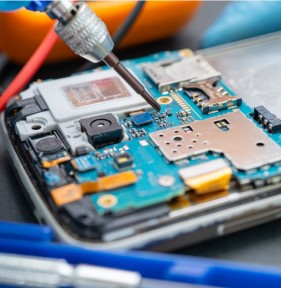This blog is the third in a series based on the report, “Digital Inequalities, E-Waste, & Right-to-Repair,” authored by Dr. Amy Gonzales, that highlights digital equity and device access policies. To read the earlier posts, click the linked text – Post #1 or Post #2.
Right to Repair
Related to environmentally-driven initiatives we discussed in previous installments, the right to repair (R2R) movement has gained momentum in recent years as planned obsolescence, the built-in fragility of consumer goods, has taken hold of the electronics industry. The movement is driven in part by those who want to extend the life of consumer goods as a means of reducing e-waste, despite barriers by electronic producers to do so.
It is also supported by small business owners and others who work in repair, such as DIY (do-it-yourself) repairers. As an indicator of why these stakeholders are organizing, Sabbaghi and colleagues reported that, according to US Census Bureau data, “the number of annually established firms in the consumer electronics repair and maintenance industry decreased from 4,623 in 1998 to 2,072 in 2015.”

This is due, in part, to the fact that, as the cost of electronic goods has dropped, repairability is increasingly made difficult or impossible through manufacturers’ non-repairable product design, electronic password protection, or withholding repair instructions or spare parts from the public. These tactics require consumers to return to the original equipment manufacturers (OEMS) for support when devices break or simply purchase another product.
Advocates of right-to-repair around the globe have tried to tackle various policy solutions to improving repairability across different sectors. Intellectual property, consumer, contract, tax, and chemical laws can all inform the legal standing of repair around the globe. As a few examples of the potential changes, intellectual property laws could be redrawn to allow for modifications that would maximize the lifespan of a product.
Laws could expand the legality of tools to break digital locks that prevent repair. Advocates in Europe argue for consumer products to list a “repairability score” signaling ease of repair at the point of purchase. Currently, “Fair Repair” bills, like those proposed in various U.S. states (e.g. Washington, California, Vermont), require producers to guarantee access to spare parts and manuals for a minimum number of years.
These are just a few promising policy approaches that could be taken to extend the life of home computers. Doing so provides for a robust second-hand computing market, which may have lower-price points and improve the chances that competitive, affordable repair is available. This should arguably keep devices in circulation longer, particularly for those who cannot easily afford to buy new devices and equipment.
Finally, in addition to advocating for policies protecting repair, researchers also note the importance of raising consumer awareness of repair options. Consumers may perceive repair costs as relatively high and rewards low, especially given a tendency towards novelty seeking through product consumption.
Repair is often expensive, especially given the barriers outlined above. A lack of consumer savvy about how electronic products work may further increase the chances that devices are replaced rather than repaired. All of these barriers must be addressed for repair to be normalized as a viable means of reducing digital inequalities.

Counterproductive Digital Divide Policy Approaches
In reviewing research on policies related to the digital divide it is clear that, in addition to policies that reduce digital inequalities, policy approaches might also be counterproductive to those efforts, including those overemphasizing innovation or a simple lack of government intervention altogether. In the case of the former, the concern is that a government focus on innovation, efficiency, and market competition can leave citizens behind.
This is why, over the past few installments, we published portions of this report, “Digital Inequalities, E-Waste, & Right-to-Repair,” authored by Dr. Amy Gonzales, as part of a blog series on digital equity and device access policies. If you’d like to read the report in full, you can access it here. We conclude the series with some possible next steps in implementing these policies as well as counterproductive digital divide policy approaches.
Although such policies are often undertaken in good faith, such as eGovernment initiatives, policies that move government services online in an effort to save money or outreach to constituents might, in some cases, actually further disenfranchise those with compromised access to technology. There are a handful of studies exploring the lack of federal policies in different contexts.

In some cases this seems to be an intentional deference to market forces over government interference (e.g. Mexico, United States). In other cases, it may reflect unstable central governments lacking an infrastructure to successfully implement widespread internet and computing subsidies (e.g. Pakistan).
Often, geography plays a role in persistent underdevelopment. Laying cable and setting up far-reaching towers can be difficult in mountainous and other remote regions, making the urban-rural divide one of the most persistent demographic predictors around the globe.
Next Steps
Given the range of policy levers available to those interested in reducing digital inequalities, it is important to consider how this information covered over these series of posts can best be used. The first step may be simply to increase awareness of these policies and the way they intersect with the digital divide.
The need for enhanced consumer awareness came up repeatedly in literature outlined across this report, especially in trying to elevate the visibility of buy back and donation programs. Making consumers aware of the wide range of approaches to supporting digital equality, either through policy advocacy or individual purchasing decisions, is an important first step.
Second, the range of these policies points to opportunities for broadening the coalition of stakeholders engaged in digital equity work. Reaching across sectors may be one way to engage a new body of advocates in digital equity outcomes, even if their primary focus is on the environment or labor issues.
Finally, it is worth reinforcing the need for a holistic approach to addressing digital inequalities. Again, scholarship on the topic finds that any policy solution is only effective when it addresses multiple forms of digital need over the long term.
Summary
Because the complexity of digital technologies continues to evolve and the capacity of any given device is quickly outdated, policies must appreciate the persistent nature of digital inequalities and design solutions accordingly.
As an organization, Digitunity works to provide solutions to these issues and support policies that reduce digital inequity in the communities it serves. You can learn more about the advocacy work we do and how you can help here.
About the Author
Amy Gonzales is an Associate Professor in the Department of Communication at the University of California, Santa Barbara. Her work examines the digital divide, particularly short-term disruption in access to devices, and the effects of social interaction via communication technologies on well-being.
She is especially interested in these phenomena for people from disadvantaged communities. Her work aims to advance theoretical understanding and real-world solutions that may mitigate the long-term consequences of new digital infrastructures that otherwise exacerbate existing social inequalities.



